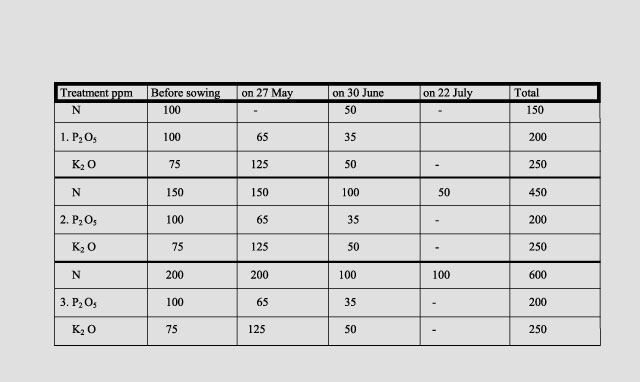
80
Effect of nitrogen on tetrahydrocannabinol (THC) content in hemp (Cannabis sativa L.) leaves at different positions
I. Bócsa, P. Máthé, and L. Hangyel
GATE "Fleischmann R." Research Institute, Kompolt 3356, Hungary
Bócsa, I., P. Máthé, and L. Hangyel 1997. Effect of nitrogen on tetrahydrocannabinol (THC) content in hemp (Cannabis sativa L.) leaves at different positions. Journal of the International Hemp Association 4(2): 78 -79. The effect of different levels of nitrogen fertilizer, of physiological age of leaves and of the interaction between these factors on the Δ9-tetrahydrocannabinol (THC) content of leaves from different positions on the hemp (Cannabis sativa L.) plant were analyzed by gas liquid chromatography. High nitrogen levels reduced the THC content of leaves, and older leaves contained less THC than younger ones. There was no significant interaction between these two factors.
Introduction
Hemp (Cannabis sativa L.) is a traditional and
important raw material for the textile industry and is currently of interest as
a wood fiber supplement in the paper industry (de Meijer and van der Werf 1994).
A significant increase in cultivation of hemp in Europe is anticipated for
future fiber production. Furthermore, drug-type Cannabis
may play an important role in future
therapeutics (Clarke and Pate 1994.). However, since one of its cannabinoid
compounds is Δ9-tetrahydrocannabinol
(THC), the psychoactive agent of the plant, its cultivation is presently
limited. Breeders have developed low-THC and high-fiber content varieties, but
some of these still contain a THC concentration verging on the EU limit for
cultivation subsidy in Europe (de Meijer et al. 1992).
Since
hemp has a high nitrogen (N) requirement, it is important to determine the
relationship between N fertilization and THC content, and (for the purpose of
analytical sampling) the interaction between N fertilizer and leaf position, in
relation of leaf THC content.
Cannabinoid
content of the leaves is known to decrease gradually from the top to the bottom
of the plant (Hemphill et al. 1980). Nitrogen content in vegetative parts
of the plant has been thought to correlate positively with its THC content
(Coffman and Gentner 1975, Haney and Kutscheid 1973).
Table 1. Fertilizer treatments in mg/kg soil.

Table 2. The effect of nitrogen treatment on the fresh weight and plant height of hemp and on the N content of the phytomass.
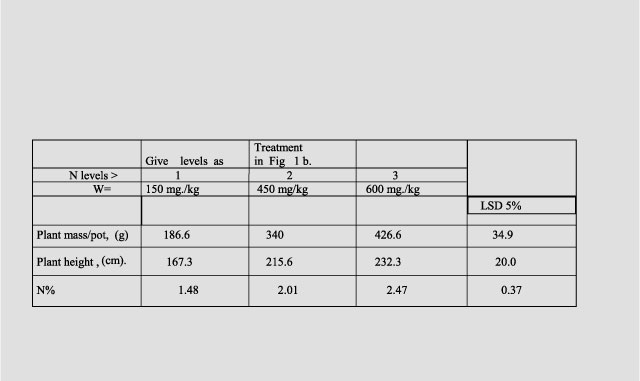
Materials and methods
The experiment was performed using 5.5 liter pots, with
two plants of the variety ‘Kompolti Hibrid TC’ per pot. This high-fiber
variety has a THC content (0.5-0.7%) exceeding the EU 0.3% subsidy limit. Pots
were placed in a glasshouse under ambient environmental conditions. A chernozem
brown forest soil from Kompolt was used (Krisztian and Hollo 1992). Treatments
are shown in Table 1.
Chemicals
used for the nutrient supply : anal. grade NH4NO3, KH2PO4,
KCl. Doses
were supplied as solutions. Date of sowing: 22 April. Date of harvesting: 13
August. The lowest N level treatment was considered as the control.
The
number of replications was six. Plants were grown until the end of flowering for
staminate plants. Leaf samples were collected on 13 August in the following way:
every leaf of both the staminate and pistillate plants was collected, dried at
40°C for 24 hr, ground, weighed, homogenized, and stored in a refrigerator at
3°C for 90 days. Leaves were placed into three groups: (a) older leaves that
occur along the middle part of stem, (b) leaves from the side branches, and (c)
younger leaves that occur near the top of the stem.
THC was
extracted from the dried leaves with petroleum ether for 3 hr at RT. (Hanus et
al. 1981). Analyses were performed with a Hewlett-Packard 5890 series II gas
liquid chromatograph. Parameters of analyses were: HP-1 capillary column, 0.3 ID
x 25 m length; injector temperature 260°C ; split ratio 1:70; detector
temperature 300oC. Analyses were programmed from 190 to 265°C at 15C/min with
an 11 min and a 5 min internal plateau at 235°C and 260°C, respectively.
Initially,
an analytically pure THC standard was not available, so areas of THC peaks were
used for characterization of THC content. The peak identification of cannabidiol
and THC was carried out according to Hanus et al. (1981). Subsequently,
CBD and THC standards were obtained and the original data were verified with
these standards. The back-calculation of the data to an absolute value is
analytically incorrect in our opinion, so this determination was not made.
The
statistical significance of factors presumably affecting the THC content of
leaves was determined by analysis of variance. The first factor was (a.) the
leaf position on the plant, and the second factor was (b.) the nitrogen
treatment.
Table 3. Analysis of variance of N fertilizer experiment (in a randomly arranged bifactorial split-plot experiment with six replications).
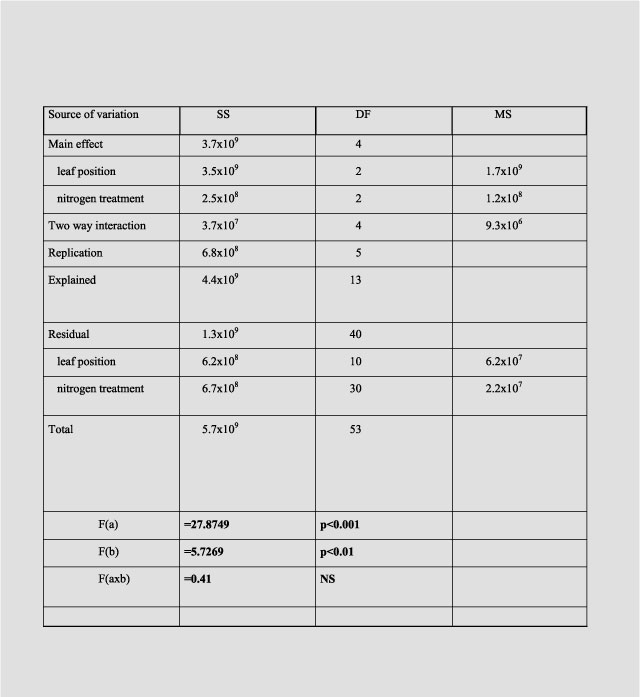
Results
There was a significant increase in fresh weight of shoot
(80-130%) and plant height (28-39%) due to N supplimentation (Tab. 2). THC was
highest in leaves near the shoot tip and on side branches, and lowest in oldest
leaves (Fig. 1a). THC content of leaves of each plant part decreased in response
to N fertilizer (Fig. 1b).
The
decrease was significant in the case of the highest N dose (Fig. 1b). THC
contents of leaves from various plant regions were significantly different,
independent of the N level (Tab. 3, see: F-value of Factor "a") The
other factor, N fertilizer treatment, also had a statistically significant
effect on THC content of leaves (Tab. 3, F-value of Factor "b"). There
was no interaction between the two factors (Tab. 3, F-value of Factor "a X
b") in relation to leaf THC content.
Figure 1. Effect
of examined factors on THC content of hemp leaves :
a.) THC content of leaves from different positions on the hemp plant (means of
three levels of N fertilizer).
b.) Effect of N fertilization on the THC content of hemp leaves (means of three
positions on the plant).
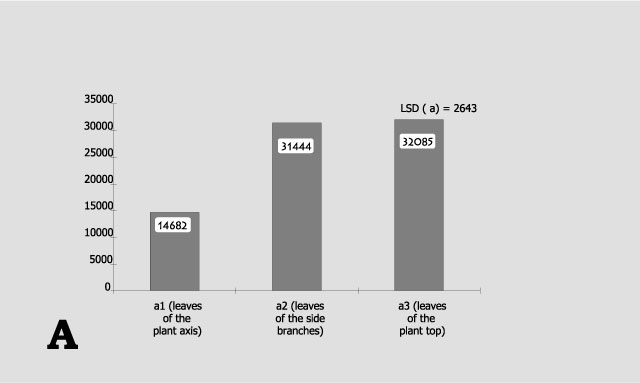
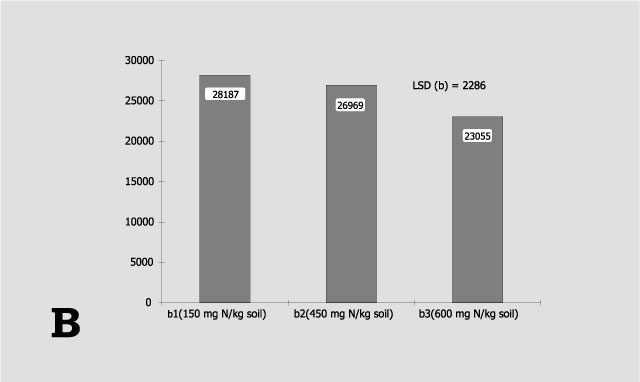
Discussion
These experiments show that the THC content of leaves
decreases with increasing N doses. This phenomenon is favorable for agricultural
production, because nitrogen fertilization will increase stem yield and
simultaneously decrease THC content of the plant significantly. Additional
studies are necessary to determine optimal N dose/ha, time of application,
fertilizer type and the lowest THC content achievable under field conditions.
References
Acknowledgments
The authors thank the National Research Fund of Hungary (OTKA),
for financial support of this research, Prof. Paul G. Mahlberg (Indiana
University, Bloomington, U.S.A) and Mr. László Pummer ("Fleischmann
R." Institute, Hungary) for their help.